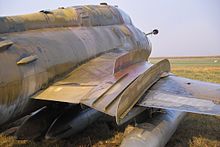Boundary layer fence

A boundary layer fence is an aerodynamic aid to improve the flow separation behavior on aircraft wings . The boundary layer fence is a web attached to the wing in the direction of flow, which prevents the cross flow in the boundary layer and thus prevents the flow from flowing away to the tip of the wing. The boundary layer fence is mainly used with heavily swept wings to prevent the flow separation on the outer wing in the area of the ailerons , which leads to the aircraft tilting.
Boundary layer fences divide the wing into several sections. Modern design methods for aerofoils usually make it possible to dispense with boundary layer fences, which are therefore increasingly viewed as an emergency solution.
history
The wing fence was 1938 from that in the Messerschmitt AG working Wolfgang love developed and patented. The first flight with boundary layer fences took place on September 16, 1939 in Augsburg with a Messerschmitt Bf 109 B-1 (D-IHHB, WNr. 290). The attempts were successful and brought significant improvements in slow flight characteristics. However, there was no series launch in Germany. Spanish licensed buildings partly had this invention.
It was only after the Second World War that the MiG-15, an aircraft with extensive use of boundary layer fencing, came into service. The corresponding wings had previously been tested with the La-160 . As a result, boundary layer fences were also widely used in civilian models, including the first jet airliners Comet , Tu-104 and Caravelle . The Tupolev Tu-160 uses a unique version of a boundary layer fence , as it is only folded upwards when the wings are pivoted at 65 °. At smaller angles, the fence serves to cover the gap between the wing and the fuselage.
Disadvantage radar echo
The aerodynamic advantages are offset by the disadvantage of strong radar echoes. The actually smooth wing surface only throws back radar echoes at certain angles. Boundary layer fences (made of metal) on the upper side of the wing act like reflectors and thus form strong radar echoes (technical term "radar flares"), which can lead to the aircraft being easily located. After this effect was recognized, the boundary layer fences on newer military aircraft soon disappeared. Modern military aircraft designs manage entirely without boundary layer fences. Underwing stations also have a similar effect on the underside of the wing , which is why these two features are no longer found in modern stealth aircraft.
More options
In addition to boundary layer fences, there are other ways to stabilize the flow above the wing - especially above the outside area:
- Saw tooth (aerodynamics)
- Vortex generator
- Sucking off / blowing out the boundary layer
- Strake
- Canard wing
Web links
Individual evidence
- ↑ Patent DE700625 : Device for preventing the spread of flow disturbances on aircraft wings.
- ↑ Radinger, Schick: Messerschmitt Me 109 - The most built fighter in the world. ISBN 3-925505-32-6 , p. 123.
- ↑ Piotr Butowski: Blackjack profiles . In: AIR International, May 2000, p. 287
- ↑ Doug Richardson: STEALTH - Invisible Airplanes. Verlag Stocker-Schmid (Motorbuch Verlag), 2002, ISBN 3-7276-7096-7 (Original: Stealth Warplanes. 2001)